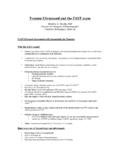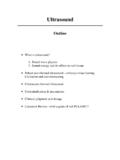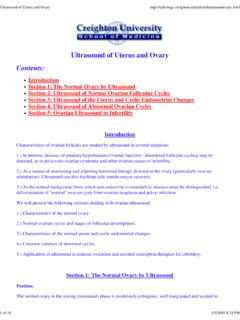Transcription of Ultrasound Billing CPT Codes Summary and Notes
1 Ultrasound Billing CPT Codes Summary and Notes CPT Codes for Ultrasound examinations are considered to be complete studies unless specified as limited studies in their code definitions. A limited study would address only a single quadrant, a single diagnostic problem or might be a follow-up examination. One should be aware that the use of modifiers may draw attention to the claim by the payer and may prompt requests for additional information. -26 Professional Component - The professional component, indicated by the 26 modifier, is typically reported by the physician for professional services and includes interpretation of diagnostic tests/studies with preparation of a separate distinctly identifiable signed written report.
2 - Unmodified Codes are utilized by physician offices, clinics or free standing emergency facilities not operated by a hospital, that provide professional services as well as own and maintain the equipment. Hospital-based Emergency Physicians would report Ultrasound CPT Codes with the professional component modifier 76815-26 (Echography, pregnant uterus; limited; professional component). -52 Reduced Services - The typical procedure was not performed as described, but rather at some reduced level of service. -59 Distinct Procedural Service - This modifier is used to report procedures that are distinct but have the same CPT code . - Example would be foreign bodies in each upper extremity -79 Repeat Procedure by Same Physician - The -76 modifier would be appropriate if the repeat exam was performed by the same exact Emergency Physician or if the patient had been signed out to another Emergency Physician and this second Emergency Physician repeated the study.
3 -77 Repeat Procedure by Another Physician - This modifier defines a repeat procedure by another physician during the same patient encounter. - As always the medical necessity for repeating these procedures should be documented in the chart in addition to applying the modifier. Need to be aware of accepted ICD-9 Codes that would support the medical necessity of corresponding Ultrasound CPT Codes A first-pass edit rejection may be reimbursed after appeal when the service provider can demonstrate the medical necessity of the Ultrasound procedure. Trauma Ultrasound : - There is no CPT code that specifically describes the emergency Ultrasound trauma examination as this is not a single Ultrasound procedure - Currently, there are three CPT Codes which reflect separately identifiable elements of the FAST exam as described by the AIUM/.
4 ACEP documents: 1) cardiac 93308-26, 2) abdomen 76705-26, and 3) chest 76604-26. - These CPT Codes must be used judiciously and must be supported by ICD- 9 Codes , which provide evidence of medical necessity for each Ultrasound examination. OB/Gyn scans: - If the physician is utilizing Ultrasound to evaluate the pregnancy or a suspected complication of pregnancy, then the obstetric pelvic Codes would be utilized ( limited pelvic Ultrasound in a woman known to be pregnant (76815-26) or complete transvaginal pelvic Ultrasound in a woman known to be pregnant (76817-26 with or without -52 modifier for reduced level of service). - If pregnancy is documented to be absent prior to the Ultrasound examination and Ultrasound was utilized to evaluate pelvic pain, amenorrhea, vaginal bleeding or non-gynecologic pelvic pathology, then the non-obstetric pelvic Codes would be utilized ( limited transabdominal pelvic Ultrasound in a woman known to be not pregnant (76857-26) or complete transvaginal Ultrasound in a woman known to be not pregnant (76830-26 with or without -52 reduced service modifier).
5 This would hold true even if the result of the subsequent Ultrasound examination was an intrauterine or ectopic pregnancy. - Transvaginal examination in pregnant and non-pregnant women may be utilized to gain a higher resolution view of pelvic anatomy and is appropriately coded with either 76817-26 (pregnant) or 76830-26 (non-pregnant). - The planned sequencing for every transabdominal Ultrasound to be followed by a transvaginal Ultrasound would be inappropriate. - If complete evaluation of the pelvic anatomy is not performed, the -52 modifier should be used. This should always be the case in my opinion. AAA and urinary tract/post-void: - Symptoms concerning for AAA or an emergency Ultrasound of a patient with suspected hydronephrosis would be coded for by 76775-26, a limited retroperitoneal Ultrasound .
6 - If sectional views of the kidney were imaged in this same patient, the limited retroperitoneal code (76775-26) would still apply and would not be separately billable. - A specific code exists for measurement of post-void residual volume by Ultrasound (51798-26: measurement of post-voiding residual urine and/or bladder capacity by Ultrasound , non-imaging). - 76857 should be utilized when an actual image of the bladder is obtained and evaluated for abnormalities. For example, in addition to reporting on post-residual volume, one would be expected to comment on the presence of bladder diverticula when present. Cardiac: - Transthoracic evaluation of the heart to evaluate for pericardial effusion, cardiac function in arrhythmia or etiology of hypotension would be coded by 93308-26, a limited transthoracic echocardiogram.
7 Biliary: - Evaluation of the gallbladder for gallstones would be coded by 76705-26, a limited abdominal Ultrasound . DVT: - Two-point compression Ultrasound of the lower extremity to evaluate for DVT would be coded by a limited duplex scan of the extremity veins (93971-26). Soft Tissue/MSK: - The most common use for soft tissue Ultrasound is to distinguish between cellulitis and abscess. - No specific code exists for soft tissue Ultrasound - The reduced service modifier (-52) is not required for any of the soft tissue Codes - Coding for MSK applications is not well developed. The only existing Codes are extremity Ultrasound , non-vascular, B-scan and/or real time with image documentation (76882-26), complete infant Ultrasound hip, and limited infant Ultrasound hip (76886-26).
8 - Emergency ultrasounds to evaluate for foreign bodies, abscess, tendon laceration as well as other focused area of an extremity would be appropriately coded for with 76882. (76882- Codes for a non-vascular extremity limited: includes report on specific anatomic structure such as a soft tissue mass, specific tendon.). - Ultrasound for miscellaneous musculoskeletal indications including fracture evaluation, tendon rupture, or muscle tear would all be coded by 76882-26. Ocular: - Ocular Ultrasound is used to detect posterior chamber and orbital pathology as well as evaluation of the optic nerve sheath diameter. All of these studies would be appropriately coded by 76512-26, ophthalmic Ultrasound , diagnostic, B-scan (with or without superimposed non-quantitative A-scan).
9 Ocular foreign body has a separate code (76529-26). Ultrasound Guidance Procedures: - 3 main categories: 1. Ultrasound -guidance for needle placement (76942-26). 2. Ultrasound -guidance for vascular access (76937-26). 3. Ultrasound -guidance for pericardiocentesis (76930-26). - Ultrasound -guidance for needle placement (76942-26) continues to apply to virtually all localization and needle placement procedures performed by Emergency Physicians other than vascular access and pericardiocentesis (including paracentesis, thoracentesis, suprapubic aspiration, lumbar puncture, foreign body removal, etc). Requires permanently recorded images Does not required a real-time image of the needle in the target - For vascular access (76937-26), we interpret the CPT requirements for recorded images as requiring an image of the target vessel, but not necessarily an image of the needle in the vessel as it is entering.
10 We recommend permanent recording of the selected vessel or of the needle entering the vessel when this is feasible and safe, while using a procedure note to document the procedure was performed with concurrent real-time visualization. - Diagnostic and procedural ultrasounds may be billed on the same day during the same encounter as long as each one is not subsumed in the other. For example, if a focused cardiac Ultrasound was performed to diagnose the tamponade, then a diagnostic code and a procedural code would be appropriate. Regarding Payer Policy and coverage: - ICD-9, the International Classification of Diseases, 9th Revision, is a cataloging tool developed by the World Health Organization for the international comparison of morbidity and mortality data.





